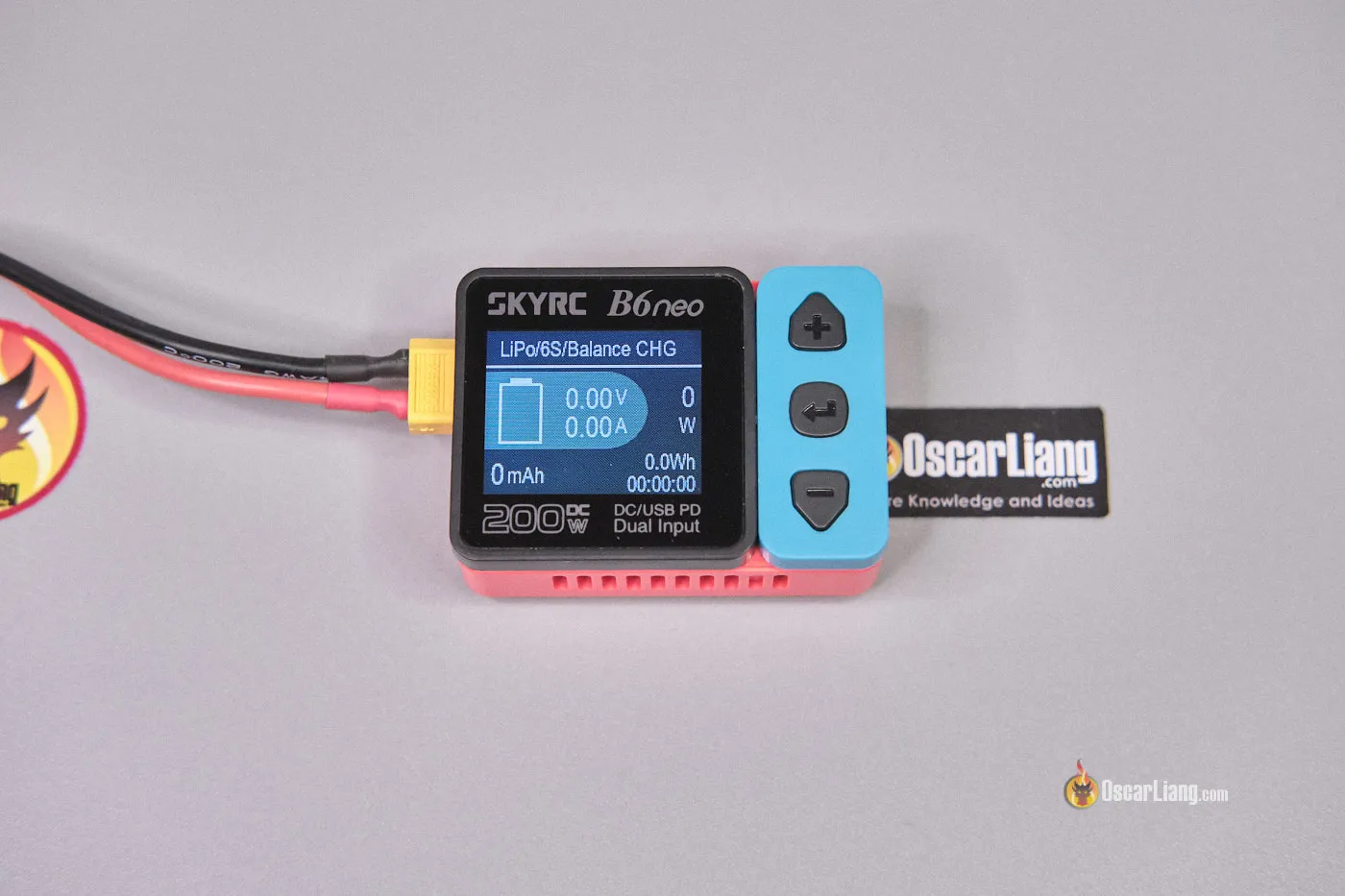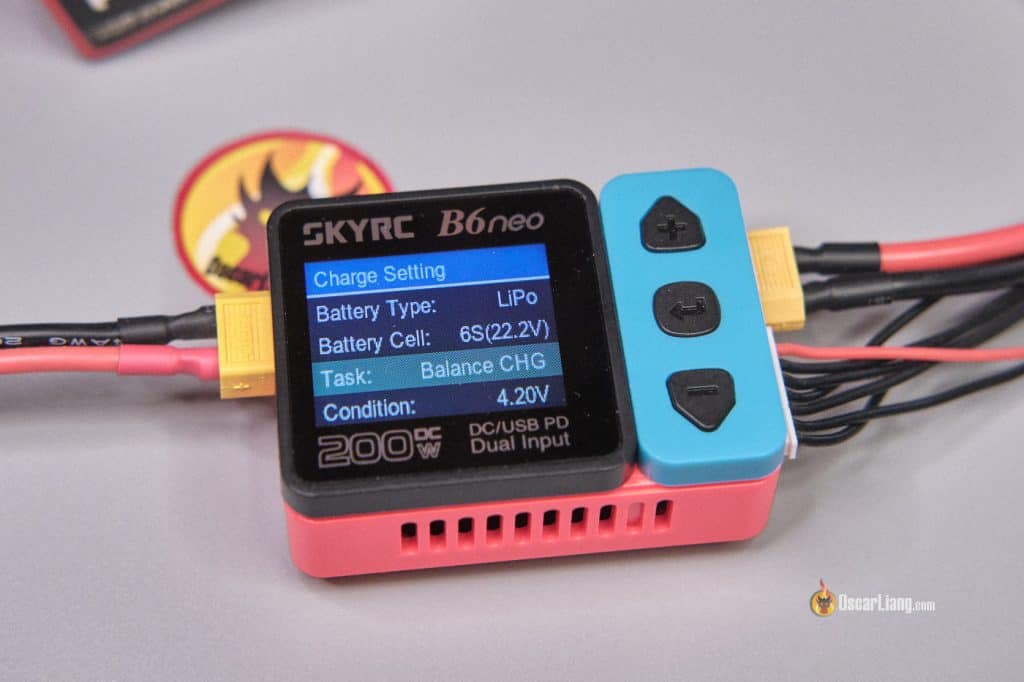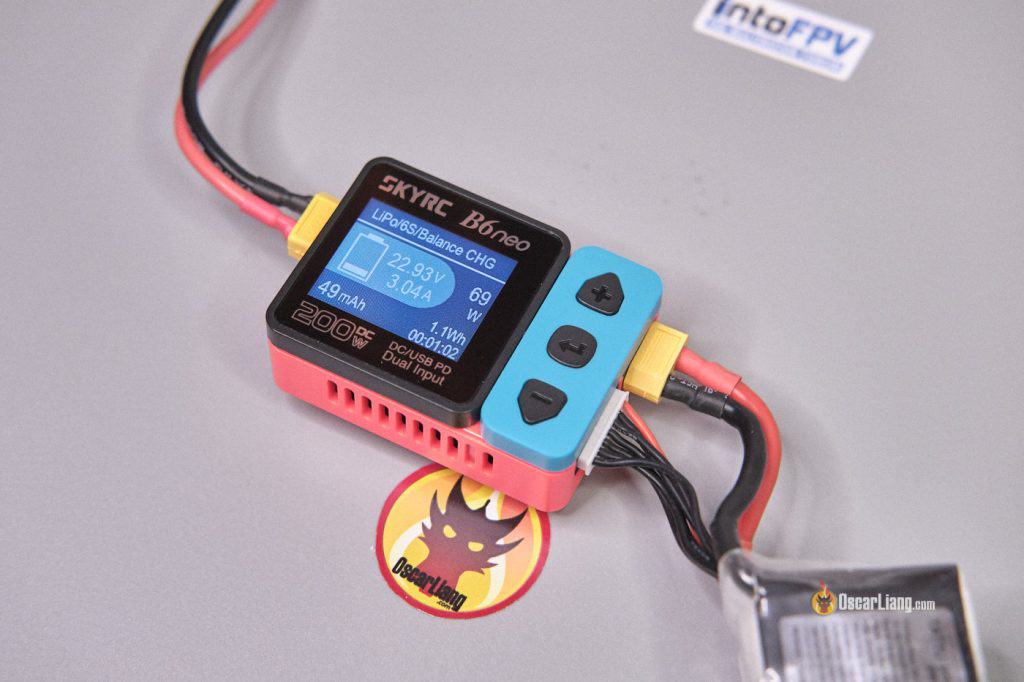The SkyRC B6neo is an affordable, portable LiPo battery charger that’s compact and lightweight, making it the ideal solution for refuelling your batteries on the move. With a power rating of 200W, it’s well-equipped to handle the demands of daily use. And, at a modest price of just $36, it’s an excellent choice for beginners who don’t want to break the bank. But does it deliver in terms of performance and reliability? Let’s dive in and explore in this review.
New to FPV? Learn more about LiPo charger in this buyer’s guide: https://oscarliang.com/choose-lipo-battery-charger-power-supply/
Table of Contents
Where to Buy
You can get your SkyRC B6 Neo charger from the following vendors:
- AliExpress: https://s.click.aliexpress.com/e/_DFnuemV
- GetFPV: https://oscarliang.com/product-dmtq
- RDQ: https://oscarliang.com/product-arfb
- Banggood: https://oscarliang.com/product-utze
Included in the package, you’ll find the charger and a user manual.
Specifications
The B6neo charger has the following specifications:
- Input voltage: DC 10.0-28.0V, PD3.0/QC 12.0-20.0V
- Input current: DC 12A, PD 5A
- Maximum output power: DC 200W, PD 80W
- Working mode:
- LiPo/LiFe/LiIon/LiHV: Balance CHG, Charge, Storage, Discharge;
- NiMH/NiCd: Charge, Re-Peak, CYCLE_C_D, CYCLE_D_C, Discharge;
- Pb: Normal, AGM Charge, Cold Charge, Discharge;
- DC power supply 5.0-27.0V, 1.0-10.0A
- Supported Battery type/cells:
- LiPo/LiFe/LiIon/LiHV 1S-6S,
- NiMH/NiCd 1S-15S,
- Pb 3S/6S
- Charge current:
- LiPo/LiFe/LiIon/LiHV 0.2A-10.0A,
- NiMH/NiCd 0.2A-10.0A, Pb 0.2A-10.0A
- Discharge current: Current 0.1A-2A
- Power: Max. 24W (±10%) based on 6S(4.2V/cell)
- Balance current: LiPo/LiFe/LiIon/LiHV Max.500mA
- Size: 70x50x32mm
- Weight:
82g83.3g
Notable Features
The SkyRC B6neo charger is not just about raw specifications. Here’s what sets it apart:
- Compact and portable design.
- Equipped with XT60 and USB-C Input Power Options, supporting DC 10.0-28.0V and PD3.0 12.0-20.0V.
- Capable of charging 1S to 6S LiPo and Li-ion batteries.
- Provides a decent maximum output of 200W.
- Compatible with a wide range of battery types.
- Can double as a power supply.
- Also serves as a battery voltage checker.
- Equipped with an error and warning system for enhanced safety and troubleshooting.
- Offers Balance Charge and Direct Charge modes.
- Features voltage calibration capabilities.
- Available in a fantastic selection of colors to suit your style.
A Close Look at the B6Neo
The SkyRC B6 Neo has a stylish and compact design, making it easy to carry and store. It’s the details that excite me – the option of five unique color combinations adds a personal touch, making the user experience that much more enjoyable.
Traveling with my drones requires a lightweight and portable setup, and this charger fits the bill perfectly. Check out my travel setup here: https://oscarliang.com/fpv-drone-travel-setup/
The small form factor and stylish design aren’t the only reasons I am excited about the B6neo, it also has both XT60 and USB-C input. This means you can power it from a PD3.0 power source, such as a power bank or USB adapter – incredibly handy when you’re on the move. I use this Anker 65W USB-C adapter to power my charger: https://amzn.to/3VE3yro
Powering the B6 Neo through USB-C only gives you 80W of power. If you want the full 200W charging power, you have to use a bulkier external power supply (PSU) and power the charger via XT60. Here are my PSU recommendations (240W or higher is preferred): https://oscarliang.com/choose-lipo-battery-charger-power-supply/#Choosing-the-Right-Power-Supply-for-Your-Charger
Previously, the only charger accepting USB-C PD input was the ToolkitRC M4 Pocket, which I loved. However it can only charge up to 4S batteries. In contrast, the B6 Neo supports up to 6S – a desirable feature nowadays because 6S is just as popular as 4S, if not more popular. It’s also more powerful than the M4 Pocket, at 200W vs 80W when powered through the XT60.
The output is a XT60 connector – I might sound picky, but I wish it had a XT30 connector as well just like the M4 Pocket. I found it to be really helpful and I used it quite often for charging small batteries. You could just get an XT60 to XT30 adapter I guess.
Don’t let the $36 price tag fool you. The B6neo doesn’t compromise on features or performance. It’s compatible with a wide range of batteries, including LiPo, LiHV, Li-ion, LiFe, NiMH, NiCd, and Pb.
The user interface is similar to the SkyRC D200Neo I recently reviewed. Like the D200Neo, the available charger modes include Balance Charge, Charge, Discharge, and Storage.
Why two charge modes, you ask? The Charge function (direct charge) allows you to charge without connecting the balance lead, although this isn’t recommended as it doesn’t monitor and balance individual cell voltages. Use Balance Charge whenever possible. Most other smart chargers only allow Balance Charging for safety reasons. Having the Direct Charge option in the B6Neo provides flexibility but also introduces a level of risk for newcomers.
Like the D200Neo, the B6neo can double as a power supply. This comes in handy if you need to test your drone or power devices with DC input, like my favourite HGLRC RC2 / SI012 soldering iron. It offers a voltage output of 5.0-27.0V, current output of 1.0-10.0A, and maximum power of 200W.
Its system settings include safety timer, maximum capacity, trickle charge, holding voltage, language, minimum input voltage, LCD backlight, volume, completion signal, and DC power settings.
Overall User Experience and Potential Issues
My experience with the B6neo shows that SkyRC has addressed several issues I pointed out during my review of the D200Neo.
For example, checking battery internal resistance (Batt IR) during charging is now as easy as pressing the + button. No more going into the system menu for a “battery performance check” just for that.
Moreover, the B6neo now displays the input voltage – a feature hidden in the 200Neo. It takes a few presses of the + button to reveal this, which isn’t exactly user-friendly. I would prefer a status bar to constantly display key information such as input voltage, output power, and charger temperature etc. This is a common feature in many other popular smart chargers on the market.
In contrast to the M4 Pocket, which has preset charge current levels you can cycle through (1A, 2A, 3A, and 5A), the B6Neo allows you to customize charging current with a single press, much like traditional chargers. While this may not be as simple as the M4 Pocket’s near plug-and-charge operation, it offers you more control over the charge current.
However, setting charge current on the B6 Neo can be a sluggish process. The charger takes a moment to respond to user input. When you want to move to a much higher or lower value, holding down the + or – button can help you avoid repeatedly pressing these buttons. However, the jumps are inconsistent, often landing on an unexpected value. It would be better if holding down the + or – buttons could change the value in fixed increments, like 0.5A or 1.0A.
Like the D200Neo, you can’t adjust the current during charging on the B6neo – you must stop charging to set the current, which is slightly inconvenient.
Oddly enough, when I was charging at full power (200W), the charger consistently stopped at the 1-minute mark. It seems as though this behavior is programmed into the charger. To avoid this, I had to slightly lower the charge current to bring the output power lower to around 180W – 190W. It’s unclear if this is a bug or an intentional feature.
The charger can also be used as a battery checker, a handy feature. No need to power up the charger – just plug in the balance lead of the battery you want to test.
Although SkyRC claims a maximum discharge power of 24W, I found it to be closer to 21W. Not a deal-breaker, but worth noting.
When powering the B6Neo via USB-C, I can only get a maximum output power of 51W, not the 80W claimed (I tried various 100W and 65W power supplies, same result).
Hopefully, future firmware updates can address some of these issues. Speaking of which, there’s no mention of how to update the charger firmware. I assume it’s done via their “Charger Master” computer program by connecting to the USB-C port, but the program failed to detect the charger when I tried it. I’m still waiting for more information from SkyRC on this matter.
Here’s a screenshot of some parts of the manual:
Voltage Reading Accuracy
To ensure the accuracy of the D200Neo charger, I went ahead and cross-verified its voltage measurements in all connectors. The results were quite satisfactory, affirming that the charger’s voltage readings are sufficiently precise for hobbyist use. It also provides an option to calibrate voltage in the system menu if required.
Here is a comparison of charger-reported voltage readings versus Digital Multimeter (DDM) readings:
| Source | Charger Report | DDM |
|---|---|---|
| Output XT60 | 25.20V | 25.19V |
| Cell 1 | 4.20V | 4.199V |
| Cell 2 | 4.20V | 4.199V |
| Cell 3 | 4.20V | 4.192V |
| Cell 4 | 4.20V | 4.203V |
| Cell 5 | 4.20V | 4.190V |
| Cell 6 | 4.20V | 4.188V |
| Input XT60 | 25.20V | 25.19V |
How to Calibrate Voltage
My charger seemed pretty well-calibrated straight from the factory, so I believe calibration is not necessary for most users. However, if you decide to calibrate yours, ensure you are using a calibrated multimeter.
The calibration process for the B6neo charger is as follows (steps from the manual):
- On the main interface, press the “+” button twice to enter the interface of battery resistance.
- Connect the 6S battery to B6neo.
- Hold the ENTER and “+” buttons together to enter the calibration interface.
- Press the “+” button to go through the voltage of each cell.
- Press the ENTER button to choose the voltage, the value of which will turn blue.
- Press “+” or “-” to adjust the values.
A List of Errors and Warnings
In the event of a fault, B6neo will display an error message, helping users to troubleshoot issues effectively. Here is a list of Errors and Warnings as mentioned in the B6neo charger manual:
- DC In Too Low! – DC input voltage is lower than preset.
- DC In Too High! – DC input voltage is higher than preset.
- Connection Break! – The battery may be broken.
- Cell Error – The cells do not match.
- Battery Type! – The battery type is wrong.
- Overcharge Capacity Limit! – The charged capacity reaches the preset capacity limit.
- Over Time Limit! – The program is timed out.
- Int.Temp.Too High! – The internal temperature is high.
- Over Load! – The charger is overloaded.
- Reversed Polarity – The battery connection is reversed.
- Fully Charged – The battery is fully charged already.
- Outlet Volt. Too Low! – The DC output voltage is too low.
- Outlet Overload! – The DC output is overloaded.
- Balance Connection Error! – The balance connection is interrupted.
- Cell Volt Diff. – The voltage difference between each cell is high.
- Set Power Error – There is an error in setting the DC power.
Please refer to the manual for more detailed information on each error and warning, and how to resolve them.
Conclusion
The SkyRC B6Neo is an exciting new charger. It’s cheap, with exceptional specifications and performance. The charger is great for travel and serves as a perfect entry point for beginners on a tight budget.
You can get your SkyRC B6 Neo charger from the following vendors:
- AliExpress: https://s.click.aliexpress.com/e/_DFnuemV
- GetFPV: https://oscarliang.com/product-dmtq
- RDQ: https://oscarliang.com/product-arfb
- Banggood: https://oscarliang.com/product-utze
In my testing, I noticed that the charger didn’t quite reach the claimed 80W output when powered via USB-C, topping off at about 51W. As such, investing in a 65W USB adapter should be adequate: https://amzn.to/3VE3yro
If you’re looking to get the charger’s full potential of 200W charging power, you’ll need an external power supply (ideally 240W or higher): https://oscarliang.com/choose-lipo-battery-charger-power-supply/#Choosing-the-Right-Power-Supply-for-Your-Charger
While there’s certainly room for improvement on the performance and user interface to enhance user experience, I’m hopeful that these fixes can be incorporated through software updates.
The B6Neo has effectively replaced the ToolkitRC M4 Pocket as my preferred travel LiPo charger, mainly due to its ability to charge 6S batteries and function as a battery voltage checker. While the M4 Pocket is a solid option and offers a simple plug-and-charge experience, its lack of 6S support, limited 80W output power and fixed charging current limits its versatility.
How to Update Firmware
Here’s how to update the firmware for the SkyRC B6Neo LiPo battery charger.
Download and install the latest version of Charger Master (Windows program): https://www.skyrc.com/downloads/
The steps to update your firmware are as follows:
- Simultaneously press the ‘+’ and ‘-‘ buttons while connecting the charger to your PC using a USB cable.
- Open Charger Master.
- Click the button labeled “Check For New Version”. If any new firmware versions are available, click the “Update” button.
- When the firmware upgrade is complete, the charger display will turn off.
- Before using the device, please power it off and then power it back on.


















18 comments
I’d be amazing to power up the charger from the lipo that is connected to the balance lead (right side), to put the lipo in storage when it’s charged, without needing any additional power supply.
For now I do with with 2 lipos, one to power up the B6 neo, but I find it inconvenient and unnecessary and It’d be amazing if this option existed.
Thanks for the detailed review, but I find one important thing missing at least for me, balance current is only 500 mA, we all know that that balancing process starts at the end of the charging cycle, does that mean that it takes more time to fully charge, let’s say compared to d200 neo with 1500mA balance current.?
Does it need a 6S battery to be connected in order to calibrate? I only have a 4S and pressing the + and Enter button at te same time in the resistance screen doesn’t seem to work.
It’s best to use a 6S battery so that you can calibrate all 6 cells. Using a 4S will only calibrate the first 4 cells of the balance port. But if will only charge 4S battery this might be ok.
Thank you! I ended up buying a 6s balance connector and soldering up a harness to connect 6x 1s lipos.
I keep getting dc in too high while using usb c connector. The Manual don’t really help.
Hey Oscar!
Thanks for the great article, I decided to buy 2 of those for my travel setup but I have an issue with them. The stock calibration is pretty bad (I have a calibrated multimeter, one of these show 0.5V less, the other one shows 0.5V more per cell…).
I tried to calibrate but couldn’t save the result, so it went back to the previous values right after, do you know how to save it? I tried with original and updated (latest version right now) firmware but it’s the same, I tried pushing everything, power cycling etc. but it immediately forgets it.
Thanks in advance for your help!
When calibrating, use the +/- to adjust the value, and hold down the Enter key to confirm/save the value, when it’s saved the value should turn blue.
After setting the correct value for each cell and saving, it displays in the center of the screen instead of maintaining the correct V values.
Hi Oscar! Have you checked this video by RC Video Reviews claiming 80% of failure? youtube.com/watch?v=6iOVhe1HOB0 – quite concerning. I just received mine and it’s showing exactly the same grinding fan, and finally dying fan issues.
I’ve been using mine in the field since I received it and it’s been working fine as expected. Could be a quality control issue as I only tested one unit. It’s best to contact SkyRC for a solution if yours have issues.
I just got mine and it blew up as soon as i connected xt60 lead. apart from reading voltage from balance lead it is paperweight
For me it does output 80W from USB-C 20V/5A charger
I found a way to update the firmware.
Open the “Charger Master” program, press and hold the “+” and “-” buttons before connecting the USB C cable.
,B6neo will display Update Wizard V1.01
,Charger Master will show connection status and show current firmware : 1.55
A great addition for a travel setup!
Is there any information available on which balance connectors fit this charger? I see many offers having a “set” option that includes an adapter board.
All my batteries are JST-XH(R) already and all of them fit the balance port on the old B6.
There’s only one type of balance connector for LiPo batteries and they are all the same as far as i know. The only difference is the number of cells, which affects how many pins/holes in the connector.
Looks really good, iv’e been searching for a good usb-c charger and couldn’t find many options.
this seems to check all the boxes.
nice… finally something for 6s powered by usb-c. great when traveling